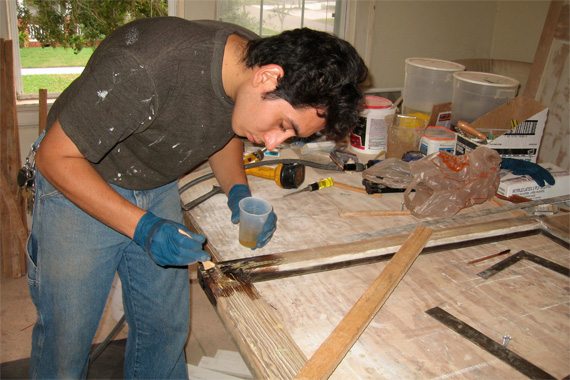Perhaps your wood sashes are cracked, peeling, and prone to rattle in the wind. Or the insulated glass in your vinyl casement is “blown” — filled with foggy condensation. Maybe your aluminum slider gave up sliding years ago. You’ve got a window problem, and you know it’s going to cost you.
Confronted with such ills, many home owners leap to the conclusion that it’s time to replace their windows. That’s an expensive proposition: A double-hung 3-foot-by-5-foot vinyl replacement window costs $300 to $500 installed.
Fact is, none of the symptoms mentioned above necessitate new windows. By repairing windows with a few dollars and some sweat equity, most problems can be remedied. In addition, you’re likely to improve the energy efficiency of the windows you fix. You can avoid the cost of window replacement by addressing some of these scenarios.
All-Wood Windows
When maintained, wood windows can last 100 years or more; if left unpainted, they quickly degrade. However, even after years of neglect, the damage is often superficial, looking worse than it is. There’s no need to assume the window must be rebuilt. Areas of rotted wood can be renewed with penetrating liquid epoxy. Fill holes in sills and sashes with epoxy putty — it sands easily and is paintable.
Cost: About $20 for enough epoxy putty to mend a 3-by-5-foot window, $10 for paint and primer to protect your work. Allow three to six hours per window for the restoration.
Because sashes and stops wear with age, wood windows are prone to gaps where air can penetrate. Popular spring bronze weather stripping has a V-shape cross section. The flexible shape applies continual pressure against the window sash and permanently seals gaps while allowing sash movement. Other weather-stripping solutions include tubular vinyl and adhesive foam.
Cost: About $21 for enough spring bronze weather stripping to seal a 3-foot-by-5-foot window. Allow an hour per window for installation.
Older double-hung wood windows have counter weights to assist raising the sashes. These can be repaired to working order, but the real problem is that the weights and pulleys require a sizeable cavity in the wall that’s not insulated. This void contributes to heat loss. New replacement lifting mechanisms attach to the sash, allowing the cavity to be filled with expandable foam.
Cost: $38 for a replacement lifting mechanism, $4 for spray foam insulation. Allow four hours per window for installation.
Non-Wood Windows
Windows made of vinyl, fiberglass, and aluminum will last at least 20 years. Unfortunately, the gaskets that seal their sashes don’t have the same life expectancy. Repair holes and small rips by removing the sash and applying silicone sealant to the damage. To replace the gaskets, contact the window manufacturer or a specialty supplier for replacements.
Caulk any punctures or cracks in vinyl- or aluminum-clad windows to prevent water damage to the wood core. Repair loose aluminum sashes by tightening the screws at the corners; try coating the screw threads with a dry-locking compound made for especially for screws.
Cost: A few dollars for silicone or replacement gaskets and parts. Allow an hour or so per window.
Energy Savings
Any repairs that improve the ability of your windows to seal against air leakage will yield energy savings. The worse shape your windows are in, the greater the potential savings on your fuel bill — a Vermont field study suggests that sealing a single loose window can save $14 to $20 annually.
But don’t expect more than a couple hundred dollars overall—even some total replacements don’t yield more than that. The real savings is the money you didn’t spend on replacement windows.
Glass Issues
In most wood windows, glass is “glazed” in place, held with small metal pieces called points and sealed with putty. Even when the glass is sound, cracked and missing putty should be replaced. Glazing takes practice but is well worth the trouble.
Cost: $6 for points and putty; $32 for two pieces of single-pane glass to refit a 3-foot-by-5-foot window. Allow three hours per window.
Replace cracked single-pane glass. To remove the old glass from a vinyl window, pry away the vinyl stop with a putty knife. On aluminum windows, the glass is wrapped with a rubber gasket and held by a metal strip. Remove both to free the glass. To re-install, a bead of silicone seals the glass on a vinyl window; for a metal window, clean and reuse the rubber gasket.
Cracked or fogged double-pane windows should be resealed or replaced by a glass fabricator—find them in the Yellow Pages or online directory.
Cost: $175 for double-pane glass to refit a 3-foot-by-5-foot window.
Hardware Failures
Before replacing a balky cranking mechanism on a casement or awning window, try cleaning it and lubricating with white lithium grease. If that doesn’t do the trick, replace the mechanism.
Cost: About $3.50 for lithium grease; $40 should you need a new mechanism. Allow a half hour for lubrication per window; two hours for replacement.
Broken or paint-encrusted sash latches should be replaced.
Cost: From about $10 for a standard brass latch to $40 for an antique reproduction. Latches come in a range of finishes, from brushed metal to colored enamel. Allow about 15 minutes for the switch out.
